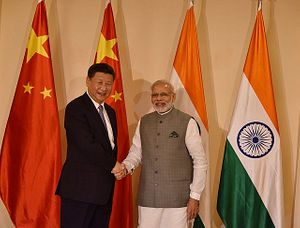The BRICS annual summit was held this week from September 3-5 in Xiamen, China, and was attended by the heads of state of Brazil, Russia, India, China and South Africa. The theme of the five-member group’s ninth summit was “BRICS: Stronger Partnership for a Brighter Future.” The summit was particularly significant as it was held against the backdrop of recent border discord in the Doklam area in the Himalayas between India and China.
The 73-day standoff between the two countries had casted shadow over the possibility of a successful summit this year. However, the standoff came to an end significantly days before the BRICS summit was scheduled to be held in China. The Indian Ministry of External Affairs issued statement on August 28 announcing “expeditious disengagement of border personnel at the face-off site at Doklam.” The ministry clarified in a separate statement the next day that Prime Minister Narendra Modi would be visiting China for the BRICS summit. China’s Foreign Ministry spokesperson Hua Chunying maintained that “Indian personnel and equipments have been withdrawn to the Indian side of the boundary” and “in light of the changes on the ground” China will make “necessary adjustments and deployment.” Talking about BRICS, she argued that “China stands ready to make active efforts and play a positive role in ensuring the success of the event.” Although there were differences in the manner in which disengagement was announced by the two sides, it nevertheless cleared the path for the 2017 edition of the BRICS summit.
The Xiamen Declaration signed by the members during the summit emphasized that BRICS, as a forum, has “fostered the spirit of mutual respect and understanding, equality, solidarity, openness, inclusiveness and mutually beneficial cooperation,” among the members and reiterated the shared desire for “peace, security, development and cooperation.”
One of the major highlights of the summit from India’s point of view was that for the first time the group’s declaration specifically named Pakistan-based terror groups like Lashkar-e-Taiba (LeT), Jaish-e-Mohammad (JeM) and the Haqqani network. The Joint Declaration condemning terrorism stated “concern on the security situation in the region and violence caused by the Taliban, ISIL/DAISH, Al-Qaida and its affiliates including Eastern Turkistan Islamic Movement, Islamic Movement of Uzbekistan, the Haqqani network, Lashkar-e-Taiba, Jaish-e-Mohammad, TTP and Hizb ut-Tahrir.” The statement mentioned that “we deplore all terrorist attacks worldwide, including attacks in BRICS countries, and condemn terrorism in all its forms and manifestations wherever committed and by whomsoever” and emphasized that “those responsible for committing, organizing, or supporting terrorist acts must be held accountable,”
The inclusion of JeM and LeT in the Xiamen Joint declaration is viewed as a significant diplomatic success for India. It is the first time that China has signed such a statement which names Pakistan-based terrorist groups. In the past, Beijing repeatedly blocked New Delhi’s bid, which was also backed by United States, Britain and France, to declare Jash-e-Mohammad’s chief Masood Azhar, as a UN-designated terrorist. PTI reported that Chinese Foreign Ministry spokesman Geng Shuang said that by naming outfits like JeM and LeT, the BRICS countries have “shown their concerns to the violent activities raised by these organizations.” However, this move may have implications for China crucial relationship with Pakistan.
On the last day of the summit, Indian Prime Minister Narendra Modi and the Chinese President Xi Jinping met on the sidelines for their first substantive bilateral meeting post-Doklam. Commenting on the meeting, the Indian Foreign Secretary S. Jaishankar said that “it was a forward-looking conversation” with an emphasis on “peace and tranquility on border areas.” He added that both the sides felt that there should be “closer communication between the defense and security personnel of India and China.” Soon after the meeting Modi took to Twitter and wrote “met President Xi Jinping. We held fruitful talks on bilateral relations between India and China.”
Later in the day, China’s Foreign Ministry spokesperson Geng Shuang’s argued that during the meeting Xi stressed the need for “sound and stable” China-India relations. Xi emphasized that China and India are “each other’s important neighbor” and should focus on “seeking common ground while shelving differences and uphold peace and tranquility in our border areas” to bring the bilateral relationship “on a right track,” under the “guidance of Five Principles of Peaceful Coexistence.”
The reference to the “Five Principles of Peaceful Coexistence” or Panchsheel Agreement was particularly interesting, as an attempt to mend bilateral ties after the Doklam faceoff. The five principles, as per the Panchsheel agreement which the two countries had signed on April 29, 1954, are: mutual respect for each other’s territorial integrity and sovereignty, mutual non-aggression, mutual non-interference, equal and mutual benefit and peaceful coexistence.
India and China, being the two largest economies of the BRICS, are the group’s most crucial members. For a long time trade and economics have been the key drivers of their bilateral relationship, while tricky geopolitical issues have continued to overshadow more productive aspects of their relationship at times. Recurrent tension over the issues like Doklam, which is set aside for now, China’s One Belt One Road (OBOR) initiative, and India’s reservations over the China Pakistan Economic Corridor (CPEC), continue to remain major irritants in the bilateral relationship. However, during the 2017 BRICS summit the two side displayed significant diplomatic maturity, creating space despite difference for multilateral cooperation on broad range of issues, enabling what was termed as successful and productive summit.
Pragya Pandey is a New Delhi-based scholar. She has a PhD from Jawaharlal Nehru University, New Delhi and primarily works on the Indian Ocean and the wider Indo-Pacific region.































